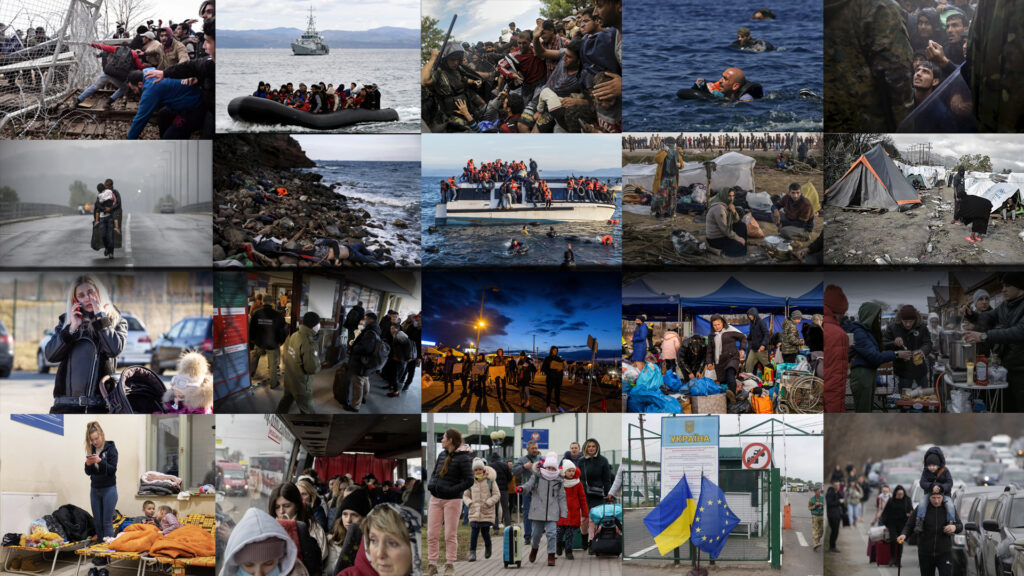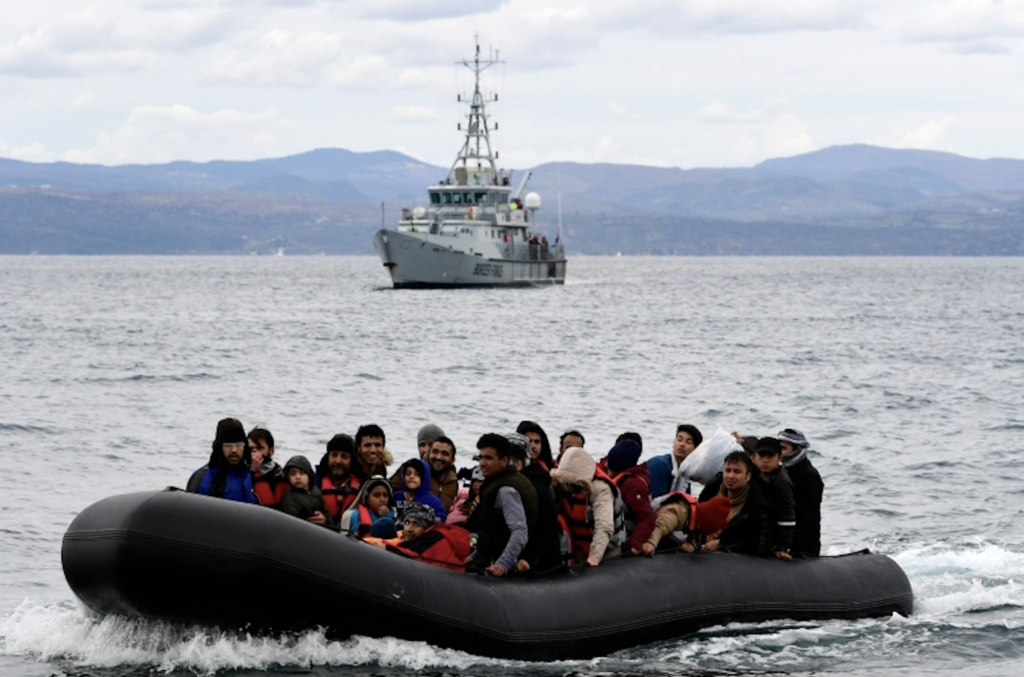
The UN estimates that more than 10 million people may flee their homes in Ukraine.[1] Accepting refugees is not something new for Europe. Since the 2015 Refugee Crisis, the European shores have welcomed millions of displaced Syrians, Afghans and refugees of other Middle East wars.[2] Arabs have been treated as foreigners, while Ukrainians are welcomed as friends. This leads to the question of how do race, religion and politics influence the different treatment of refugees?
Arab refugees are unwelcomed in Europe. When seeking entry in Europe they face potential drowning, harsh living conditions in refugee camps, and local authorities’ efforts to stop them from advancing into Western Europe. Violent pushbacks from EU authorities,[3] and insufficient rescue workers led to a tragic average of five dead migrants per day on the Mediterranean Sea en route to Europe in 2021.[4] Turkey alone receives billions of Euros of EU support to host refugees and halt their travel to Europe.[5]

On the other hand, Europe has rapidly embraced, accepted and protected Ukrainian refugees. Recent pictures, like the ones in my collage above, show warm food awaiting Ukrainian refugees at the other side of the border, the demonstrated unity shown between the EU and Ukraine, well-organized transportation efforts, and hospitality from neighboring countries’ citizens. People literally opened their homes for refugees to stay, with volunteers in neighboring Polish borders offering transportation and accommodation.[6] And while EU member states usually accept around 10% of asylum applications,[7] all Ukrainian refugees were granted asylum for 3 years. This prevents some of the pressures of the asylum-seeking process, which deepen and increase PTSD.[8] In comparison with the Arab refugees the conditions seem notably supportive. One can see the clear fear and exhaustion in Ukrainians’ faces, but the images convey the support they are receiving.
So why are Ukrainians being treated so differently?
Ukrainian refugees are predominantly White and Christian. Blond and tall with blue eyes, Ukrainians align with typical features of Western attractiveness. Even if they are Slavs, having different backgrounds and heritage, their appearance is very “European.” Ukrainian refugees are perceived by Western societies, media and politicians as “brothers” that need to be rescued. International geopolitics play their role too, since the West is trying to isolate Russia by all means, including support and solidarity towards Ukrainians. To make it simple, Ukrainians are seen as Europeans. Thus, it seems that value of human life is judged on one’s origins, religion and appearance.
Arab refugees, because of their race and darker skin tone are perceived by many white Europeans as alien and aggressive. Integration into societies is difficult due to regional cultural chasms. Different attitudes like their perception of community with “lack of cohesiveness and stability in social relations, which manifests itself on all levels beyond that of the primary family group,” (Bruhns, 2007, pg. 133) and lower average levels of education distance large parts of Western societies.[9]
The different religion creates a fear to many Europeans called Islamophobia[10], a form of racism and prejudice connecting all refugees with Islamist extremists/terrorists. This may be more obvious in nationalist, right-wing audiences, but can be spotted in the moderate, general public as a fear of the unknown and different. In fact, back in 2010, a shocking 41% of people in France opposed the construction of new mosques.[11] With the rise of Islamic terrorism in Europe the past 5 years, the anti-Arab sentiment is even bigger with “Islamophobic statements spread in national media to laws and policies that restrain the fundamental rights of European Muslim citizens[12].” Popular French far-right Presidential contender, Marine Le Pen rhetoric has even gone so far as to suggest that the Islamic ideology wants “to bring France to its knees[13]”, reflecting a hostility of a significant conservative part of the French electorate. Le Pen received 23.2% of the votes in the first round election of April 10th 2022.[14]

Unsurprisingly, many countries (like far-right Poland and Hungary) closed their borders to Arab refugees[16]. Yet at this time, the same governments, hostile to Middle Eastern Muslims consider it their duty to aid Ukrainian people.
“These are not the refugees we are used to; these people are Europeans. These people are intelligent. They are educated people… This is not the refugee wave we have been used to, people we were not sure about their identity, people with unclear pasts, who could have been even terrorists. In other words, there is not a single European country now which is afraid of the current wave of refugees”
Bulgarian Prime Minister Kiril Petkov, Feb. 28th [17]
Refugees are categorized into “good” versus “bad” creating a racial and religious standard evaluated by nationality.
The trauma of war and leaving their countries affect refugees regardless of their country of origin, ethnicity or religion. Symptoms of depression, anxiety, panic attacks, and agoraphobia will accompany them for their whole lives[18]. Their treatment and perception must also be equal.
Journal Sources
Bruhns, Fred C. 2007. “A study of Arab refugee attitudes.” The Middle East Journal 9(2): 130-138
Sue, Shea and Irena Papadopoulos. 2018. “European refugee crisis: psychological trauma of refugees and care givers.” International Journal of Migration, Health, and Social Care 14(1):106-116.
Jakes, Lara. February 26, 2022. “For Ukraine’s refugees Europe opens doors that were shut to others.” The New York Times. Retrieved 4 March 2022. (https://www.nytimes.com/2022/02/26/us/politics/ukraine-europe-refugees.html).
The UN Refuge Agency 2022. “Refugee Crisis in Europe.” Washington, DC. Retrieved February 21, 2022. (https://www.unrefugees.org/emergencies/refugee-crisis-in-europe/).
Secondary Sources
CNN. March 4, 2022. “More than 10 million people may end up fleeing their homes in Ukraine, UN estimates.” Retrieved March 6, 2022. (https://www.cnn.com/europe/live-news/ukraine-russia-putin-news-03-03-22/h_d6af165a4286562bbd51cfe89c05f45f).
The UN Refuge Agency 2022. “Refugee Crisis in Europe.” Washington, DC. Retrieved February 21, 2022. (https://www.unrefugees.org/emergencies/refugee-crisis-in-europe/).
Amnesty International. June 23, 2021. “Greece: Pushbacks and violence against refugees and migrants are de facto border policy.” Retrieved March 6, 2022. (https://www.amnesty.org/en/latest/news/2021/06/greece-pushbacks-and-violence-against-refugees-and-migrants-are-de-facto-border-policy/).
The National. January 11, 2022. “Five migrants per day drowned in Mediterranean in 2021.” Retrieved April 3, 2022. (https://www.thenationalnews.com/world/europe/2022/01/11/five-migrants-per-day-drowned-in-mediterranean-in-2021/).
European Commission. “The EU Facility for Refugees in Turkey.” Retrieved March 6, 2022. (https://ec.europa.eu/neighbourhood-enlargement/enlargement-policy/negotiations-status/turkey/eu-facility-refugees-turkey_en).
Daily Sabah. Feb 27, 2022. “’Outpouring of solidarity’: Ukrainians fleeing war welcome in Poland.” Retrieved April 3, 2022. (https://www.dailysabah.com/world/europe/outpouring-of-solidarity-ukrainians-fleeing-war-welcome-in-poland).
IFO 3/2016. “Asylum Applicants in the EU-an overview.” Retrieved March 6, 2022. (https://www.ifo.de/DocDL/dice-report-2016-3-wech-september.pdf).
Oxford Research Encyclopedias. 26 April 2019. “Islamophobia.” Retrieved April 3, 2022. (https://oxfordre.com/religion/religion/view/10.1093/acrefore/9780199340378.001.0001/acrefore-9780199340378-e-685).
CBC Febryary 28, 2022. “Europe’s different approach to Ukrainian and Syrian refugees draws accusations of racism.” Retrieved March 6, 2022. (https://www.cbc.ca/news/world/europe-racism-ukraine-refugees-1.6367932).
[1] CNN. March 4, 2022. “More than 10 million people may end up fleeing their homes in Ukraine, UN estimates.” Retrieved March 6, 2022. (https://www.cnn.com/europe/live-news/ukraine-russia-putin-news-03-03-22/h_d6af165a4286562bbd51cfe89c05f45f).
[2]The UN Refuge Agency 2022. “Refugee Crisis in Europe.” Washington, DC. Retrieved February 21, 2022. (https://www.unrefugees.org/emergencies/refugee-crisis-in-europe/).
[3] Amnesty International. June 23, 2021. “Greece: Pushbacks and violence against refugees and migrants are de facto border policy.” Retrieved March 6, 2022. (https://www.amnesty.org/en/latest/news/2021/06/greece-pushbacks-and-violence-against-refugees-and-migrants-are-de-facto-border-policy/).
[4] The National. January 11, 2022. “Five migrants per day drowned in Mediterranean in 2021.” Retrieved April 3, 2022. (https://www.thenationalnews.com/world/europe/2022/01/11/five-migrants-per-day-drowned-in-mediterranean-in-2021/).
[5] European Commission. “The EU Facility for Refugees in Turkey.” Retrieved March 6, 2022. (https://ec.europa.eu/neighbourhood-enlargement/enlargement-policy/negotiations-status/turkey/eu-facility-refugees-turkey_en).
[6] Daily Sabah. Feb 27, 2022. “’Outpouring of solidarity’: Ukrainians fleeing war welcome in Poland.” Retrieved April 3, 2022. (https://www.dailysabah.com/world/europe/outpouring-of-solidarity-ukrainians-fleeing-war-welcome-in-poland).
[7] IFO 3/2016. “Asylum Applicants in the EU-an overview.” Retrieved March 6, 2022. (https://www.ifo.de/DocDL/dice-report-2016-3-wech-september.pdf).
[8] Sue, Shea and Irena Papadopoulos. 2018. “European refugee crisis: psychological trauma of refugees and care givers.” International Journal of Migration, Health, and Social Care 14(1): 106-116.
[9] Bruhns, Fred C. 2007. “A study of Arab refugee attitudes.” The Middle East Journal 9(2): 130-138
[10] Oxford Research Encyclopedias. 26 April 2019. “Islamophobia.”Retrieved April 3, 2022. (https://oxfordre.com/religion/religion/view/10.1093/acrefore/9780199340378.001.0001/acrefore-9780199340378-e-685).
[11] Foreign Policy in Focus. “Europe’s Islamophobia.” Retrieved April 18, 2022. (https://fpif.org/europes_islamophobia/).
[12] European Islamophobia Report. “2019 European Islamophobia Report | #EIR2019.” Retrieved April 18, 2022. (https://www.islamophobiaeurope.com/).
[13] Independent. 5 Feb 2017. “Marine Le Pen launches presidential campaign with hardline speech.” Retrieved April 3, 2022. (https://www.independent.co.uk/news/world/europe/marine-le-pen-front-national-speech-campaign-launch-islamic-fundamentalism-french-elections-a7564051.html).
[14] The Guardian. “French election 2022: full live results.” Retrieved April 18, 2022. (https://www.theguardian.com/world/ng-interactive/2022/apr/10/french-election-2022-projected-result-and-latest-results).
[15] Open Society Foundations. May 2019. “Islamophobia in Europe.” Retrieved April 6, 2022. (https://www.opensocietyfoundations.org/explainers/islamophobia-europe).
[16] BBC. 13 June 2017. “EU Targets Poland, Hungary, and Czechs for not taking refugees.” Retrieved April 16, 2022. (https://www.bbc.com/news/world-europe-40259268).
[17] CBC Febryary 28, 2022. “Europe’s different approach to Ukrainian and Syrian refugees draws accusations of racism.” Retrieved March 6, 2022. (https://www.cbc.ca/news/world/europe-racism-ukraine-refugees-1.6367932).
[18] Sue, Shea and Irena Papadopoulos. 2018. “European refugee crisis: psychological trauma of refugees and care givers.” International Journal of Migration, Health, and Social Care 14(1): 106-116.